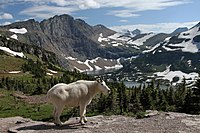
Photo from wikipedia
Research Highlights: The efficacy of planting for restoration is important for ecosystem managers. Planting efforts represent an opportunity for conserving and managing species during a population crisis. Background and Objectives:… Click to show full abstract
Research Highlights: The efficacy of planting for restoration is important for ecosystem managers. Planting efforts represent an opportunity for conserving and managing species during a population crisis. Background and Objectives: Federal agencies have been planting whitebark pine (WBP), an important subalpine species that is late to mature and long-lived, for three decades in the Greater Yellowstone Ecosystem (GYE). These efforts have been met with varying success, and they have not been evaluated beyond the first five years post-planting. Ecosystem managers will continue to plant WBP in the GYE for years to come, and this research helps to inform and identify higher quality habitat during a period of changing climate and high GYE WBP mortality rates. Materials and Methods: We use a combination of field sampling and a water balance model to investigate local biophysical gradients as explanatory variables for WBP performance at twenty-nine GYE planting sites. Results: We found that the WBP growth rate was positively correlated with actual evapotranspiration (AET) and was greatest when cumulative growing season AET was above 350 mm. Growth rate was not strongly affected by competition at the levels found in this study. However, site density change over time was negatively affected by mean growing season temperature and when more than five competitors were present within 3.59 m radius. Conclusions: If they make it to maturity, trees that are planted this season will not begin to produce cones until the latter half of this century. We recommend planting efforts that optimize AET for growth rate objectives, minimize water deficit (WD) that cause stress and mortality, and removing competitors if they exceed five within a short distance of seedlings.
Journal Title: Forests
Year Published: 2020
Link to full text (if available)
Share on Social Media: Sign Up to like & get
recommendations!